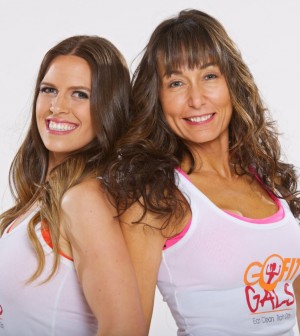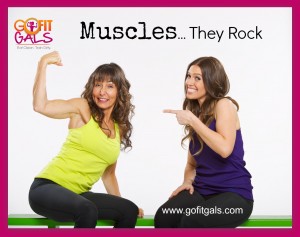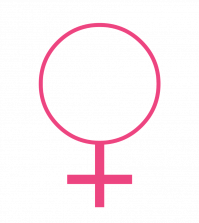- Finding Unshakable Power in a World That Wants to Pull Us ApartPosted 6 months ago
- What could a Donald Trump presidency mean for abortion rights?Posted 6 months ago
- Financial Empowerment: The Game-Changer for Women in Relationships and BeyondPosted 7 months ago
- Mental Health and Wellbeing Tips During and After PregnancyPosted 7 months ago
- Fall Renewal: Step outside your Comfort Zone & Experience Vibrant ChangePosted 7 months ago
- Women Entrepreneurs Need Support SystemsPosted 7 months ago
GO FIT: Top 4 Questions About Strength Training Answered

By PJ and Risse, The Go Fit Gals.
There are many goals that people tell me that they want their fitness programs to meet. However, the one goal that is most requested is weight loss.
Weight loss is easy, when done properly, and it can be maintained for life. However, you don’t see that too often on ol’ internet. Instead, you see yo-yo type programs that have you losing the weight, only to have it return once “off the program”.
That’s why I love our Go Fit Gals plans (however, I do recognize that I may be a tad biased). They teach people how to eat real food and real food for life. However, the other unique part of our plans is the extensive strength training programs that you get with them.
Strength training is the Queen, King and Royal Court when it comes to helping to drop those pounds and inches off – for good.
However, a lot of people don’t hit the weights because they are unfamiliar with them and/or they don’t know where to start or even why they should start.
Below are 4 of the most common strength training questions that I get asked.
How Can Strength Training Help Me?
Strength training is the only means of fighting that age-related business of muscles wasting away.
As we age our muscles reduce in both size and strength. This is called sarcopenia and it is a natural occurrence with aging. Most adults will lose between 5-7 pounds of muscle every decade and women, after the age of 30, will also decrease in muscle density and increase their intramuscular fat. This fat, which is located through the skeletal muscles, has been associated with conditions such as insulin resistance and type 2 diabetes.
Because of the loss of lean muscle mass (that happens with every passing decade), our metabolism will also decrease (by about 5% each decade). Lower metabolic rate contributes to that middle-aged spread. But, this can all be changed with a progressive strength-training workout.
You see it requires more calories for the body to keep a pound of muscle warm (because the body loves staying in a homeostasis state of 98.6 degrees Fahrenheit) than it does a pound of fat. So, the more muscle you have, the more calories you burn – at play and at rest.
More than cardio, or aerobic fitness, strength training is the key for men and women in their middle years to decrease their body fat, build their lean muscle mass, improve their bone density and increase their metabolism.
This is one of the magic bullets to our new “Hot Flash Hottie” plan. This plan, specific for peri, post and menopausal women, uses a 6-week progressive workout program. The workouts build a fitness base for our women and then each week afterwards layers on top of that base.
By the end of the 6 week plan our ladies will experience improvements of 100-600% in strength and power! No other form of exercise can do that for this population.
Other benefits of strength training include:
– Reduced risk of adult-onset diabetes
– Lower blood pressure
– Decreased arthritis pain
– Maintenance of and improvement in lower back health
Without strength training people will continue the rapid decline of lean muscle tissue as they age, which in turn will make them a fat-storing machine – instead of a fat-burning machine.
Intense strength training will also increase your BMR (Basal Metabolic Rate) and your EPOC (Exercise Post Oxygen Consumption). Both of which can lead to some serious calorie burning too. In fact, fat loss studies have proven that high intensity strength training can burn fat faster than the traditional aerobic exercise that we used to prescribe for weight loss. (Check out our YouTube channel for over 50 workouts.)
Is It Safe To Strength Train At Any Age?
You betcha! Strength training will help improve balance (therefore decreasing the risk of falling), sustain a longer independence in life and reduce the risk of osteoporosis.
In a recent study, researchers found that walking by itself was not enough of an overload to stimulate bone-building cells. Weight training and impact-type exercises were found to be more helpful.
How many reps should I do?
We have two primary types of muscle fibres: slow twitch and fast twitch (click here to see our blog “What Muscle Fibre Are You?”).
Slow twitch muscle fibres move more slowly and have more mitochondria (structures located within the muscle cell that contain enzymes needed to metabolize food into energy sources). This means that they have a higher aerobic capacity and are less resistant to fatigue.
On the other hand, fast twitch muscle fibres are characterized by their fast speed of contraction but lower level of aerobic capacity. Since we carry both sets of fibres, I always recommend periodizing a strength program of 4-8 weeks of high reps (1-3 sets of 13-20 repetitions) at a light load.
This should address the slow twitch muscle fibres. Then, for the next 4-8 week period, switch your program to a heavier load of 8-12 reps for 1-4 sets. This type of programming should avoid exercise plateaus and address both types of muscle fibres.
As A Woman, Will Strength Training Impact My Size?
I must get asked this question at least 3 or 4 times a week, and my answer is an emphatic and resounding NO. Strength training will result in a small increase of muscle size.
To get those huge muscles that you see on a bodybuilder requires high levels of testosterone, and as women we lack those levels. So, as you progress in your program and feel that you are ready, please do not be afraid to pick up those 20 and 30 pound dumbbells! (Heavy or Light Weights for Women: What’s Best for Results?)
Are Machines Better Than Dumbbells?
Machines. Suck. Period. All right, I’ll be a little generous; they are kind of good for beginners and those coming back to the gym after an injury. This is because they support the individual and help dictate the plane of motion to lift in. However, that’s precisely why I hate them too.
We should be learning to support our own bodies and move through our own range of motion, and not that of a machine. I prefer dumbbells, barbells, kettlebells, tubing, TRX, cable machines, pulley systems, stability balls, the BOSU, the Rip Trainer, medicine balls and wobble boards.
The Go Fit Gals are your experts in fitness and nutrition for women from new mommies to menopause. They provide the coaching and the inspiration to get their members strong, healthy and confident through our unique online programs based on eating clean and training dirty.







